Physical Address
304 North Cardinal St.
Dorchester Center, MA 02124
Physical Address
304 North Cardinal St.
Dorchester Center, MA 02124
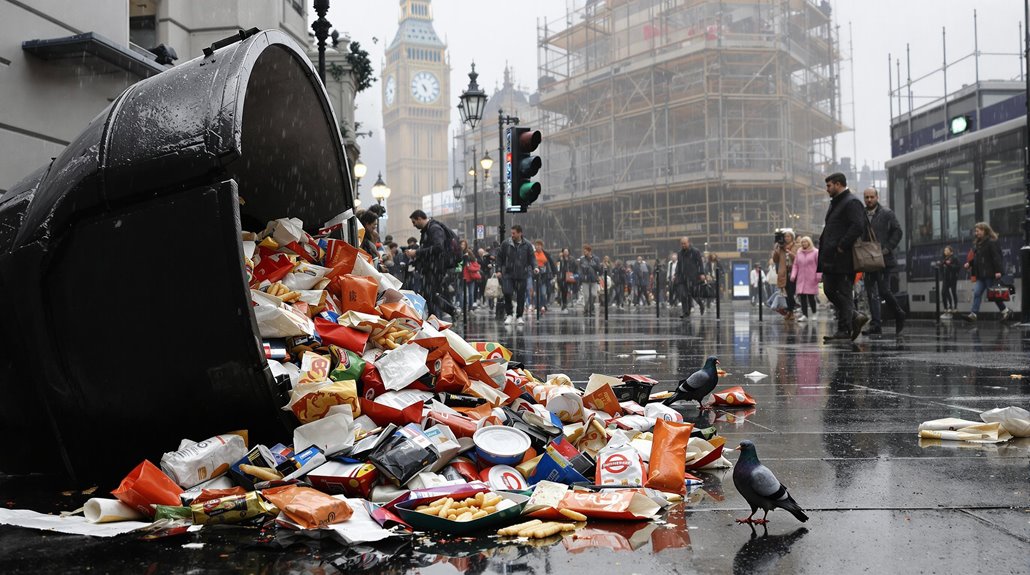
London’s notorious challenges might make you rethink your travel plans. You’ll face overwhelming crowds at major attractions, eye-watering prices for accommodation and dining, and packed Underground trains during peak hours. The city’s unpredictable weather, constant traffic congestion, and complex navigation system add further stress to your journey. With pickpocket risks in tourist hotspots and time-consuming airport commutes, there’s much more to reflect on before booking your London adventure.
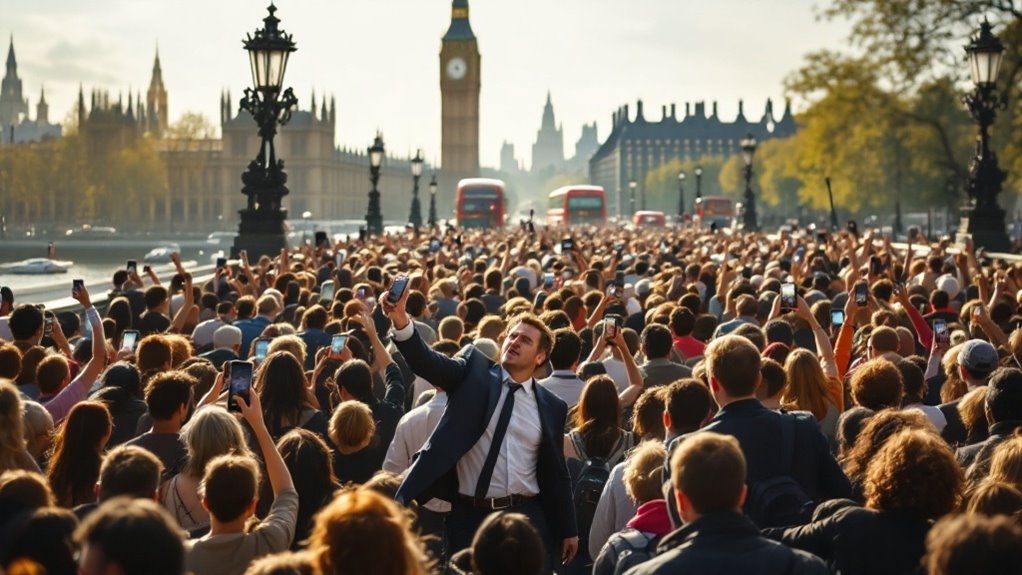
While London’s iconic attractions draw millions of visitors each year, you’ll quickly discover that the city’s overwhelming crowds can turn your dream vacation into a frustrating ordeal.
With over 30 million annual visitors flocking to major landmarks like the British Museum and Tower Bridge, you’ll find yourself constantly battling massive queues and congestion.
The tourist crush isn’t just at attractions – it’s spilling into residential areas too.
As 20.3 million international visitors pour £11.9 billion into the city, overcrowding has become a serious issue across London’s boroughs.
In areas like Newham and Tower Hamlets, where overcrowding rates exceed 22%, you’ll experience packed streets, crowded public transport, and difficulty finding space in restaurants and shops.
The housing situation is particularly dire, with 11.1% of dwellings classified as overcrowded – the highest proportion in all of England.
Many travelers are now considering cost-friendly destinations like Argentina as alternatives to expensive, overcrowded European capitals.
Consider exploring Southeast Asian cities for a more relaxed cultural experience with fewer tourist crowds.
With international tourism spending projected to grow 6% annually, these overwhelming crowds aren’t going away anytime soon.
Contrary to popular belief, personal growth isn’t guaranteed just by visiting crowded tourist destinations.
Beyond battling the endless crowds, you’ll need deep pockets to get around London using public transportation. The city’s transit costs rank among Europe’s highest, with Londoners spending up to 10% of their income just to commute – compared to Oslo residents who spend only 2%. You’ll face steep fares that consistently outpace inflation, whether you’re taking the Tube or bus. London’s reliance on fares generates 72% of operating income, significantly more than other major cities like Paris.
| Transit Type | Single Fare | Monthly Cost |
|---|---|---|
| Underground | £6+ (peak) | £150+ |
| Bus | £2 | £75+ |
| Travelcard | £13+ daily | £200+ |
Even with cost-saving options like the Oyster card, you’ll still pay considerably more than in other European capitals, where monthly passes often cost just €30-50. London’s heavy reliance on passenger revenue means you’ll bear the burden through consistently rising fares.
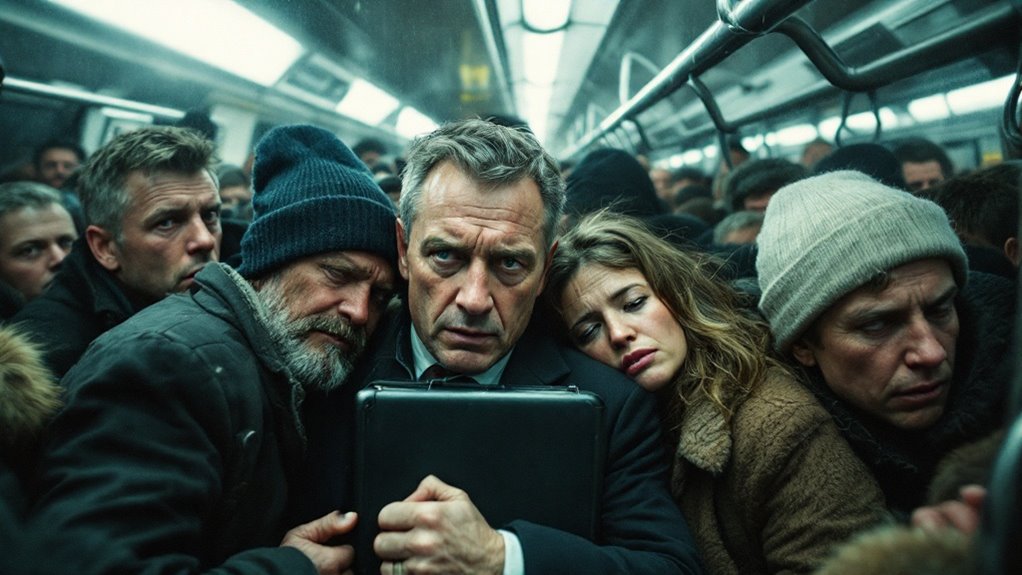
Despite its efficiency at off-peak times, London’s Underground transforms into a sardine-packed nightmare during rush hours, with major lines operating well beyond their intended capacity.
You’ll find the Northern Line running at an astounding 130% capacity during morning peaks, while the Central and Jubilee Lines aren’t far behind at 116% and 115%. This extreme overcrowding isn’t just uncomfortable – it creates genuine safety concerns, contributing to falls, delays, and heightened stress levels among passengers. For solo travelers, navigating the packed trains can be particularly challenging and overwhelming.
If you’re planning to visit London, you’ll want to avoid traveling during peak hours (roughly 8-9:30 AM and 4:30-6:30 PM) when possible. The situation improves considerably during evening rush hour with 84% capacity levels.
Tourists are often shocked by the intensity of the crowding, and you’ll likely find yourself adopting the infamous “Tube personality” – a detached, every-person-for-themselves mindset that regular commuters develop.
London’s eye-watering accommodation costs will make your wallet wince, regardless of when you visit or where you choose to stay.
You’ll find hotels averaging £158 per night, with premium locations in Bloomsbury and King’s Cross demanding over £400 during peak seasons. Even budget options won’t offer much relief, as mid-range hotels still cost around £103 per night, notably higher than in cities like Manchester or Birmingham.
If you’re hoping to save money with hostels or guesthouses, you’ll still pay about £52 per night, and only 25% of London’s hotels fall below £79 nightly. For students seeking long-term stays, the situation is particularly dire with Purpose-Built Student Accommodation reaching up to £800 per week in some areas.
The situation doesn’t improve for longer stays either, with serviced apartments seeing a 12% year-over-year increase due to rising energy costs and operational expenses.
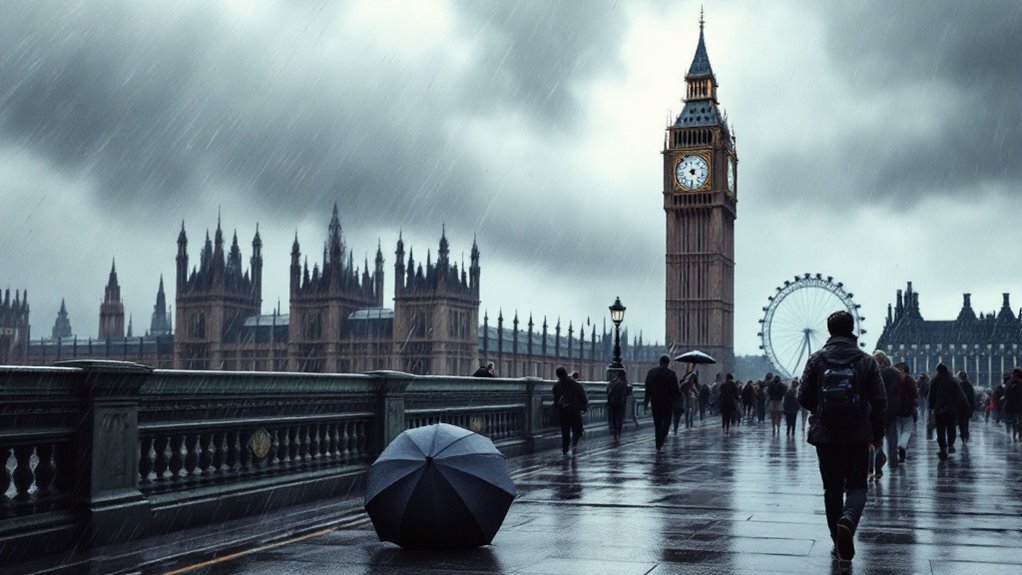
While many travelers dream of perfect weather during their London visit, the city’s notoriously fickle climate can quickly turn those dreams into disappointment.
You’ll face extreme temperature swings, from scorching 40°C summer heatwaves to freezing winter days, and most buildings lack proper air conditioning to keep you comfortable.
The city’s infamous drizzle disrupts outdoor activities for nearly half the year, with travelers encountering 113 rainy days annually, and unpredictable weather shifts mean your sunny morning could turn into a rainy afternoon without warning.
Winter brings additional challenges, with limited daylight hours and snowfall that paralyzes the city’s infrastructure.
Despite popular beliefs about constant gloom, British weather stereotypes are often exaggerated and oversimplified compared to the actual varied climate patterns.
Climate change is only making matters worse, with more frequent extreme weather events and urban heat island effects raising temperatures considerably above surrounding areas.
Pack for every season, but don’t expect reliable weather patterns.
A staggering rise in tourist attraction prices has transformed London into one of Europe’s most expensive cities for sightseeing.
You’ll need to shell out £34.80 for the Tower of London, £29 for Westminster Abbey, and an eye-watering £54 for the Churchill War Rooms, making these attractions considerably pricier than national averages.
While tourist passes like the £90 London Pass claim to offer savings, you’ll need to rush through at least three attractions daily to break even, and many popular sites aren’t even included.
Like many European capitals facing overtourism issues, Lisbon and London share similar challenges with overcrowded and overpriced attractions.
Even supposed money-saving options come with catches – Thames tourist boats charge triple the regular commuter fares, and “fast-track” entry upgrades are sold despite free timed slots being readily available.
The financial burden only increases with premium-priced food and drinks inside attractions. The historic records are shocking – St Paul’s Cathedral entrance fees have skyrocketed from £3.50 in 2006 to today’s hefty £25 price tag.
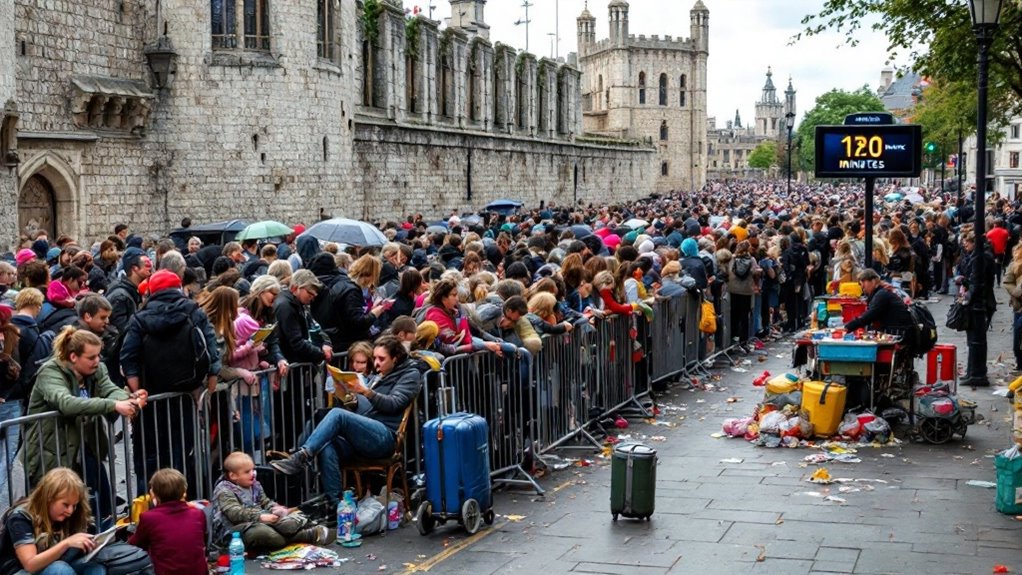
How much of your precious vacation time are you willing to spend standing in queues?
In London, you’ll face some of the most grueling wait times, especially during peak tourist season from late spring to early autumn. You’ll encounter waits of up to 45 minutes at the London Eye, even though it can hold 800 passengers per rotation, and the Tower of London’s ticket lines are notoriously long despite multiple service windows. Your best strategy is to head straight to Crown Jewels when entering the Tower of London to avoid the massive crowds that form later.
Peak season in London means enduring marathon queues, with popular attractions like the London Eye testing travelers’ patience daily.
If you’re determined to visit these attractions, you’ll need to plan strategically. Using the GPSMyCity app can help you navigate efficiently between attractions while avoiding the busiest routes.
Your best bet is to arrive during mid-week mornings when foot traffic is lower, or take advantage of the lunchtime lull between 12:00 and 14:00. For museum visits, consider late-night openings when crowds thin out.
Just remember that school holidays, bank holidays, and weekends will always bring the heaviest crowds.
Standing in long queues isn’t the only test of your patience in London – you’ll need to get used to limited personal space throughout the city.
You’ll find yourself squeezed into painfully slow buses moving at just 9.3 mph, and packed like sardines on peak-hour trains, even with the new Elizabeth line.
The situation isn’t much better when walking, as central London’s pedestrian areas operate at 90% of pre-pandemic levels, while ride-share vehicles clog up 40% of central streets.
When you’re looking to rest, you won’t find much relief in public spaces either. The stark difference from Central Park’s expanse makes London’s crowded parks even more disappointing.
Popular spots like Hyde Park face severe seating shortages during tourist season, and many major attractions now enforce standing-only zones during busy periods.
This cramped experience extends to residential areas too, with East London areas like Newham having 25.33% overcrowded households.

When visiting London, you’ll need to brace yourself for eye-watering food and drink prices that’ll make your wallet wince. The city’s dining costs greatly exceed the national average, with even basic meals straining your budget.
A typical dinner at a mid-range restaurant costs around £80 for two people. You’ll encounter markups of 15-20% compared to other UK regions, while fine dining has soared 50% above pre-pandemic rates.
Consider these sobering figures:
Even grabbing a pre-made sandwich or quick coffee comes at a premium, with prices roughly 30% higher than the UK average.
If you’re planning to drive in London, you’ll need to contend with some of the world’s worst traffic congestion, where drivers lose a staggering 101 hours annually sitting in gridlock.
The city has seen its congestion ranking skyrocket from 240th to 142nd globally in just four years.
You’ll face particularly severe delays on major routes like the A40 Westbound, where peak-hour traffic can cost you up to 63 hours each year.
The situation’s getting worse, with light goods vehicles up by 50% on urban roads since 2010, and ride-hailing services adding over 18,000 vehicles daily to congested zones.
You’ll also struggle with declining average speeds, which have dropped from 20.2 kph to 17.9 kph in central areas.
If you’re thinking about driving in London, consider that you’ll be paying both in time and money – congestion can cost individual drivers up to £942 annually in wasted time and fuel.
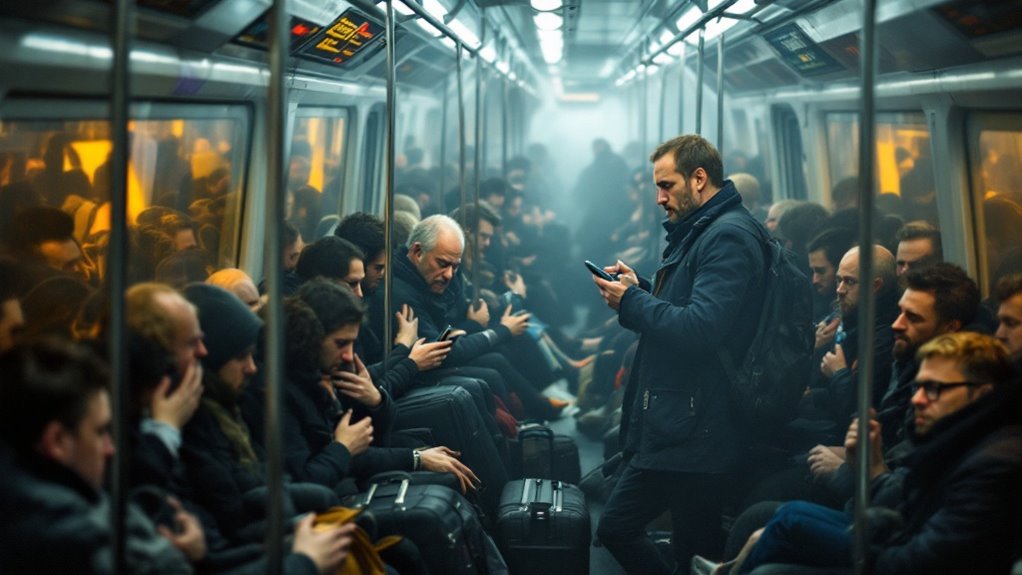
Maneuvering through London’s sprawling metropolis presents a maze-like challenge that can overwhelm even the most seasoned travelers.
You’ll face a perfect storm of navigation hurdles, from unreliable GPS signals in historic districts to confusing station names that sound frustratingly similar. The situation worsens as massive tourist crowds block pathways and create bottlenecks at major attractions.
The city’s massive size, spread across 32 boroughs, means you’ll spend precious time figuring out cross-city routes.
When you factor in weather disruptions and language barriers, finding your way becomes an exhausting daily challenge rather than an exciting adventure.
Anyone venturing into London’s tourist hotspots needs to be on high alert, as the city’s most popular attractions have become breeding grounds for sophisticated pickpockets and thieves.
Westminster alone reports over 77 thefts daily, while Camden’s theft rates have skyrocketed by 712% in three years. You’ll need to watch your belongings constantly at prime targets like Oxford Street, Camden Market, and major Underground stations.
Thieves employ various tactics, from snatching phones near closing Tube doors to orchestrating distractions with fake petitions or street games. iPhones are stolen more frequently than any other item, making them a prime target for criminals.
They’re particularly active during rush hours and peak tourist seasons, targeting unzipped bags, visible jewelry, and smartphones.
While cross-body bags offer some protection, even brief lapses in attention can result in stolen possessions, leading to disrupted travel plans and costly embassy visits.
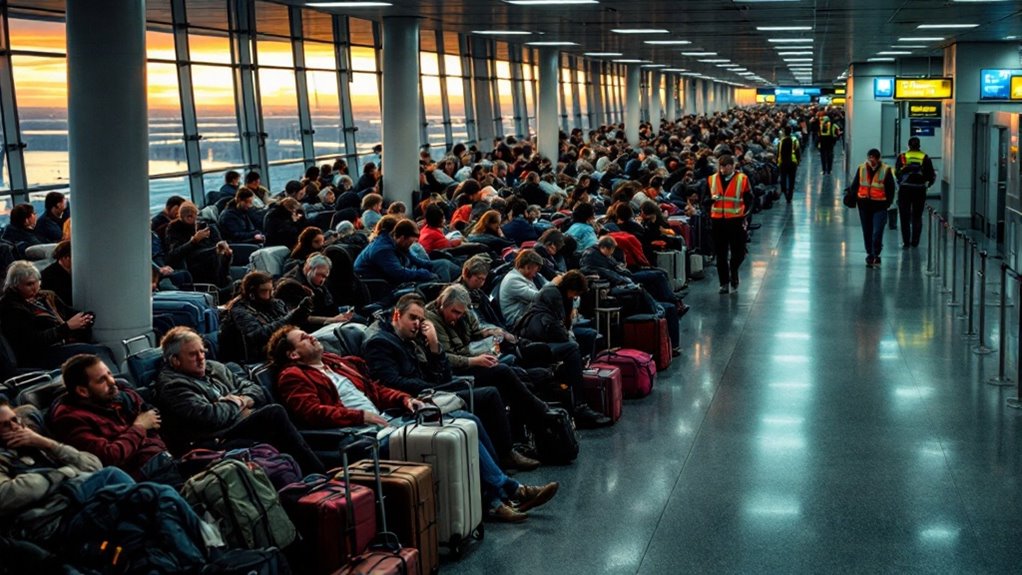
While London boasts multiple international airports, getting between them or reaching the city center can turn into a frustrating time sink that’ll seriously impact your travel plans.
London’s multiple airports may seem convenient, but navigating between them can derail even the most carefully planned itinerary.
Recent data shows that average trips take 37 minutes just to cover 10 kilometers in central London.
You’ll face significant challenges maneuvering the city’s complex transportation network, where even direct routes can take hours.
Consider these time-consuming commutes when planning layovers or multi-airport itineraries in London.
You’ll want to avoid Peckham, Tottenham, and parts of Hackney after dark. Exercise caution in Brixton, Elephant & Castle, and Bethnal Green. Tourist areas require standard safety awareness but aren’t no-go zones.
You’ll find most major London museums offer free entry to their permanent collections every day. Just remember you might need to book timed slots in advance and pay separately for special exhibitions.
You’ll find the best flight deals to London from late October through March, with January offering the lowest average fares of $413 round-trip. Winter months also feature hotel discounts alongside flight savings.
You’ll find mobile coverage is limited, with only 25% of underground stations connected. While major lines have partial coverage, you’ll experience signal drops and slower speeds during peak hours in the tunnel sections.
Like ye olde town commons, you’ll find most London parks welcome picnics. Royal Parks (Hyde, Regent’s, Greenwich) allow gatherings up to 40 people, while local parks typically permit smaller groups with basic restrictions.
Like a labyrinth with its twists and turns, London can test your patience and wallet in countless ways. While the city’s iconic landmarks beckon travelers worldwide, you’ll need to weigh these challenges against your desire to explore this historic metropolis. If you’re still drawn to London’s siren call, consider visiting during off-peak seasons and arm yourself with thorough planning to navigate these obstacles more smoothly.